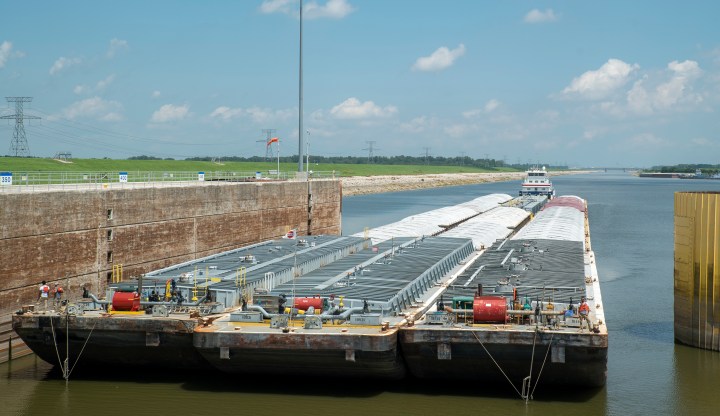
Is shipping goods by barge good for the environment?

The Mississippi River is a transportation powerhouse — especially for agriculture. Roughly 60% of U.S. grain exports are transported down the river by barge, and plenty of soybeans are moved that way too. But hot weather and drought are making it harder to move crops and goods by barge on the Mississippi. Water levels are lower this year, and that means transportation companies can’t carry as heavy a load on each vessel. That in turn, means barging is less efficient.
River barges are basically giant rafts that ship things up or down rivers, towed or pushed by a boat.
On a recent sunny day near St. Louis, a towboat slowly maneuvered 15 of these rafts tied together down the Mississippi.
The whole vessel was about a quarter-mile long, and the barges were filled with either animal feed or oil products. But barges can move a lot of other goods too.
“Rubber, scrap metal, resin for polymers like paints, varnishes, glues,” said Paul Rohde, Midwest region vice president for the Waterways Council, an organization that advocates for barge transportation.
“It’s all about capacity,” he said, noting the barge industry can move more goods with less fuel than truck or rail.
Rhode added that it would take more than 1,000 semitrucks to carry the same load as 15 barges. “Barges move products with a much lower carbon footprint than rail or certainly trucks,” he said.
The transportation sector accounts for about 28% of the greenhouse gas emissions in the United States. Trucking is obviously a big part of that number, but other transportation modes contribute too.
A Texas A&M study from 2022 found that the overall carbon footprint of barge shipping is one-ninth as large as trucking’s and about half that of rail.
But environmentalists are not sure barges are always a better alternative.
Olivia Dorothy, Mississippi River restoration director with American Rivers, pointed out that systemwide calculation misses some of the nuances of what it takes to move goods on different waterways.
“Just like cars, you’ve got different fuel economies and emissions when you drive in the city versus when you drive on the highway,” she said. “We believe that’s the same thing for our rivers.”
These are important distinctions because the Mississippi River changes so much, Dorothy said.
For example, going downriver near St. Louis, it’s the last place where barges go through a lock and dam.
The lock is like an elevator. Barges going downstream come in and are lowered to the water level in front of the dam.
It’s a process that takes time, and in terms of carbon emissions it’s sort of like a truck idling at a tollbooth. That’s why the environmental benefits of barging are in question.
“When you talk about greenhouse gases, the budget fully hasn’t been completed,” said Jonathan Remo, a professor at Southern Illinois University, Carbondale, who studies how humans affect large rivers. “We’re not accounting for the impacts of these large structures, these locks and dams we put on the landscape.”
There are dozens of them north of St. Louis and on other rivers too, like the Illinois and Ohio and the Columbia and Lower Snake in the Northwest.
There isn’t specific data on how these locks and dams add to the carbon footprint of barge transportation, Remo said.
And that means we don’t have a full picture of how green barges really are, he added. “Not having the complete information is like getting a loan and not having what the interest rate is,” Remo said.
Many of these dams are decades old and outdated. The federal government is spending billions of dollars on infrastructure for ports and waterways to keep these transportation systems running.
That’s another reason Dorothy, with American Rivers, would like more certainty that barges are a solution.
“We need to make sure that we understand how our management of the river and how we’re running these shipping vessels is contributing to the climate crisis or potentially helping if it is,” she said.
Her organization is exploring that with the help of Remo, who is working to tally up carbon emissions that come from the locks and dams on the Upper Mississippi.
He said he hopes it will be a tool to help manage our rivers and what we choose to transport on them.
There’s a lot happening in the world. Through it all, Marketplace is here for you.
You rely on Marketplace to break down the world’s events and tell you how it affects you in a fact-based, approachable way. We rely on your financial support to keep making that possible.
Your donation today powers the independent journalism that you rely on. For just $5/month, you can help sustain Marketplace so we can keep reporting on the things that matter to you.
















